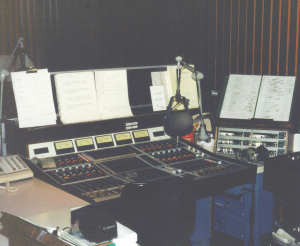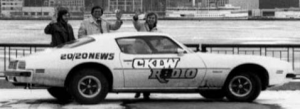
Canadian radio stations with powerful signals that reach into the United States can be highly competitive with American radio. Over the years, many major market stations from nearby Vancouver B.C. have impacted local radio in Washington State’s border towns where I live. Never before or since has there been a Canadian station that was as influential in the U.S. as was CKLW. Its studio was in Windsor, Ontario — less than 1-1/2 miles from Detroit by way of the river bridge or the river tunnel — but the station sounded American. (In its glory days CKLW was owned by RKO General, an American firm). CK’s 50,000 watt signal was top-rated in the Motor City (Detroit), Cleveland and Toledo, and it reached 18 states. The Big 8 covered Ontario and it was promoted as the most listened to station in all of Canada. Actually the numbers were even more impressive than that: CK had the 8th largest CUME audience in North America — attracting more than 2 million listeners per week.

CKLW had been around (with different call letters) since 1932. The legendary years began when the station implemented a killer Top-40 Drake format in 1967. The Big 8 flipped to an Adult Contemporary (A.C.) format 10 years later. Since the early ’70s, like other Canadian stations, CK had to contend with federal rules that required stations to air significant percentages of Canadian content. In the early ’80s, the percentage was raised once again, and that obligatory change to programming diluted CKLW’s stateside appeal. The growth of F.M. finally finished off CKLW’s dominance as a music station. In this article I will discuss the news operation; however, many well-known DJ’s graced the airwaves at CKLW. A partial list includes Charlie Van Dyke, Gary Burbank, Tom Shannon, Dave Shafer, Frank Brodie, Terry Knight, Walt “Baby” Love, Pat St. John, Kris Erik Stevens (Billy Mack), Tom Rivers, Bill Gable, Ted Richards, Scott Regen, Charlie O’Brien, and don’t forget Chuck Williams and the infamous Chuck McKay,
The Big 8 achieved high ratings by sticking to the format and by playing the hits, although there was more to the phenomenal success of CK than purely music and deejays. Most Top-40 music stations lost listeners during the top of the hour and bottom of the hour newsbreaks. The Big 8 had an antidote to that common problem: 20/20 news ran at 20 minutes before and 20 minutes after the hour. When listeners were tuning away from other stations, CKLW was still cranking hit music. There was another secret to this winning formula: News copy and news presentation had to be as exciting as the Top-40 music and the deejays. 
When the Big 8 went to the Top-40 format, Dick Smyth was the News Director. He had a high energy on-air delivery — bouncing and waving his hands and arms for emphasis. Smyth obviously knew the listeners couldn’t see his gestures, but the technique led to increased excitement in his voice. His bombastic delivery drew attention yet, as a news writer, Smyth was conventional and highly capable: well-crafted writing, stories that were catchy, but not sensationalized. Under Smyth’s leadership, the news department won the International Award of the Radio and Television News Directors Association for outstanding achievement in electronic journalism for coverage of the summer of ’67 Detroit riots. That was the first time a Canadian had won the award. Below is an aircheck of a Dick Smyth newscast from January 1969.

Dick Smyth at CKLW — (Scoped and edited. Run time 4:38)

Smyth brought his rapid fire presentation and vocal excitement to the news. But Smyth’s time at the Big 8 ended in 1969 when he accepted a position in Toronto. (He served a total of 13 years at CKLW). Management hired Gary Mack, a young Calgarian, as the Director of News and Public Affairs. Mack promptly changed his on-air name to Byron MacGregor, then he made changes in the style and the sound of the news. Bill Hennes was CKLW’s program director in the mid-’70s. He once described MacGregor’s approach to the news: “Byron converted everyday images into words that would convey the news stories to the listeners. It was a style that U.S. stations were afraid to try.” If you don’t understand Hennes’ statement that U.S. stations were reticent to follow the CK lead, it is easier to grasp his meaning by listening to a few Big 8 newscasts of the era. “Clever writing, bold, sensational presentation with an Armageddon-like delivery, stories lacking in empathy” are descriptive words that have been applied to the 20/20 news format as orchestrated by Byron MacGregor. Check out a composite aircheck below.

Four Big 8 voices: Byron MacGregor, Grant Hudson, Lee Marshall, Randall Carlisle. MacGregor’s first story is dramatically presented, with content that’s not out of the ordinary. But don’t stop there, listen to the remainder of the recording. (Scoped and edited composite. Run time 4:32)

It’s unfair to compare historical events to contemporary standards. Pragmatically, it seems safe to say that this sensational approach would not be well received by many people in the modern day. Former news director Dick Smyth was quoted as saying, several years back, that he thought the news department got off-track, became sensationalized, after he had moved to Toronto. That was his opinion, but right or wrong, the radio station was a smashing success in the ’60s and ’70s. When the Big 8 was riding high, the news staff consisted of 24 reporters.
Byron MacGregor’s fame eclipsed his role as a radio newsman and director of news and public affairs at CKLW. In 1974, upon release of his single “The Americans,” (click here to listen) he became well-known in the states. The patriotic (pro-American) commentary was huge: No. 1 in Cashbox Magazine, No. 4 in Billboard Magazine, No. 42 on Canadian charts, and 3.5 million copies sold. The script had its roots as a commentary penned by popular Canadian journalist Gordon Sinclair of radio station CFRB in Toronto. Sinclair had written it when he learned that the American Red Cross had run out of money providing aid to victims of natural disasters. Although Sinclair initially recorded the track himself, it was the golden voice of Byron MacGregor that made it famous. MacGregor was the first person to present “The Americans” on CKLW and the voice of the breakout Top 40 radio hit in the United States.
Radio Revolution: The Rise and Fall of the Big 8 is an interesting 2004 documentary that presents a detailed history of the Big 8. The short video below (click on it to play) was released publicly on YouTube — as an example of the full documentary’s in-depth analysis and content. It is informative and includes interviews with former CKLW employees. To learn more about the documentary DVD, or to purchase it, visit the Radio Revolution website (click here).


Some comments may be held for moderation. (New users)